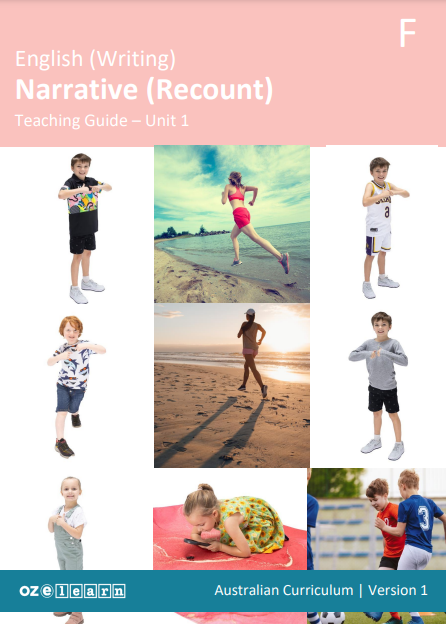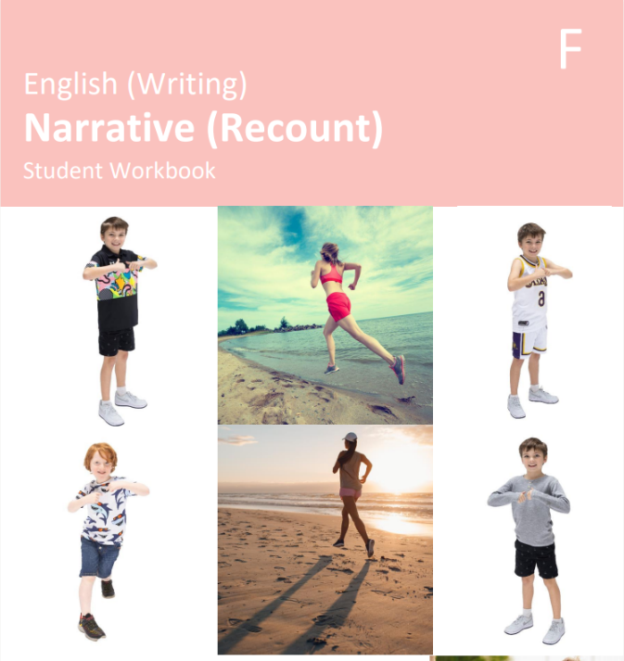Unit 1: Narrative (Recount) – Foundation Year
Oz-e-Writing

Overview
Unit 1 Narrative (Recount) is a writing program for Foundation Year students. It aligns to the Australian Curriculum V9.0.:
- AC9EFLA04 – Understand conventions of print and screen, including how books and simple digital texts are usually organised.
- Learning that Standard Australian English in written texts is read from left to right usually from top to bottom of the page.
- Discussing the placement of images and words in text.
- AC9EFLA05 – Recognise that sentences are key units for expressing ideas.
- Learning that word order in sentences is important for meaning; for example, ‘The boy sat on the dog.’ ‘The dog sat on the boy.’
- AC9EFLA06 – Recognise that sentences are made up of groups of words that work together in particular ways to make meaning.
- Learning how words in a sentence relate to one another, for example, connecting a cat (noun) to ate (verb), or black (adjective) to a cat (noun).
- AC9EFLA07 – Explore the contribution of images and words to meaning in stories and informative texts.
- Recognising that texts can be interpreted differently when only the words or only the images are read or viewed.
- AC9EFLA08 – Recognise and develop awareness of vocabulary used in familiar contexts related to everyday experiences, personal interests and topics taught at school.
- Identifying words for a topic studied at school; for example, words relevant to home.
- AC9EFLA09 – Identify punctuation as a feature of written text different from letters; recognise that capital letters are used for names, and that capital letters also signal the beginning of sentences while punctuation marks signal the end.
- Commenting on capital letters encountered in everyday texts; for example, ‘That’s the letter that starts my name.’ ‘The name of my family and my town have capital letters.’
- AC9EFLE02 – Respond to stories and share feelings and thoughts about their events and characters.
- Using drawing and beginning forms of writing to express personal responses to stories, poems or films.
- Discussing events and characters in texts and connecting them to their own experiences.
- AC9EFLY08 – Form most lower and upper-case letters using learnt letter formations.
- Follow clear demonstrations of how to construct each letter, for example, where to start and in which direction to write.
- Developing a functional pencil grip grasp.
Success Criteria
- Students say and read recounted events. Students draw a recounted event.
- Students say and read recounted events. Students cut and paste and create a recount sentence.
- Students say and read recounted events. Students trace a recount sentence with correct punctuation, letter formation, left to right sweep and functioning pencil grip.
- Students make up and jointly write recount sentences based on an exemplar sentence.
- Students say, compose and independently write recount sentences based on an exemplar sentence.
- Students demonstrate understanding of simple punctuation. Capital letters and full stops.
Learning objectives
In lessons 1 to 45, students learn:
- Standard Australian English is written from left to right.
- Word order in sentences is important for meaning.
- Relationship between words in a sentence. Syntax. Grammar.
- Recognise the importance of images in relaying meaning.
- Identify and read words used to describe everyday personal experiences.
- Recognise the role of capital letters and the function of basic punctuation.
- Use drawing and beginning forms of writing to express ideas.
- Discuss and compare sentences connected to their personal experiences.
Teaching resources
- lessons
- Teaching Guide
- Student Wordbank
- Student Workbook
- Student Assessment Workbook.
Assessment
At Foundation level, descriptive wording about students’ progress over the unit is used rather than an A–E achievement scale. The Assessment Rubric is referenced to the Foundation level achievement standard in the Australian Curriculum Version 9.0. It incorporates content descriptions and elaborations. Based on evidence, teachers make an on-balance judgement to decide which standard of performance the student is achieving. Using the Progress Tests and End-of-Unit Assessment, teachers moderate work and modify the rubric. This will provide qualitive and diagnostic feedback on student learning within the unit.
A progress test will be completed during week 3 and 6.
Each progress test will include assessment tasks that will assess the content taught during prior weeks.
End-of-Unit Assessment is to be conducted at the completion of all lessons. APPLE questions and Check for Understanding slides provide teachers with the opportunity to assess student understanding at the time of instruction and to drive classroom discussions.



Responses